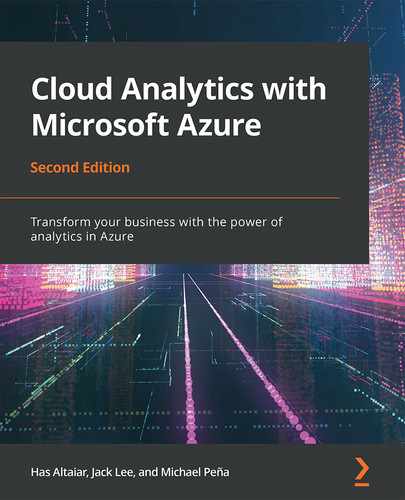Learn to extract actionable insights from your big data in real time using a range of Microsoft Azure features Cloud Analytics with Microsoft Azure serves as a comprehensive guide for big data analysis and processing using a range of Microsoft Azure features. This book covers everything you need to build your own data warehouse and learn numerous techniques to gain useful insights by analyzing big data The book begins by introducing you to the power of data with big data analytics, the Internet of Things (IoT), machine learning, artificial intelligence, and DataOps. You will learn about cloud-scale analytics and the services Microsoft Azure offers to empower businesses to discover insights. You will also be introduced to the new features and functionalities added to the modern data warehouse. Finally, you will look at two real-world business use cases to demonstrate high-level solutions using Microsoft Azure. The aim of these use cases will be to illustrate how real-time data can be analyzed in Azure to derive meaningful insights and make business decisions. You will learn to build an end-to-end analytics pipeline on the cloud with machine learning and deep learning concepts. By the end of this book, you will be proficient in analyzing large amounts of data with Azure and using it effectively to benefit your organization. This book is designed to benefit software engineers, Azure developers, cloud consultants, and anyone who is keen to learn the process of deriving business insights from huge amounts of data using Azure. Though not necessary, a basic understanding of data analytics concepts such as data streaming, data types, the machine learning life cycle, and Docker containers will help you get the most out of the book.Key Features
Book Description
What you will learn
Who this book is for
Table of Contents
- Cloud Analytics with Microsoft Azure, Second Edition
- Preface
- 1. Introducing analytics on Azure
- The power of data
- Big data analytics
- Internet of Things (IoT)
- Machine learning
- Artificial intelligence (AI)
- DataOps
- Why Microsoft Azure?
- Security
- Cloud scale
- Top business drivers for adopting data analytics in the cloud
- Rapid growth and scale
- Reducing costs
- Driving innovation
- Why do you need a modern data warehouse?
- Bringing your data together
- Creating a data pipeline
- Data ingestion
- Data storage
- Data pipeline orchestration and monitoring
- Data sharing
- Data preparation
- Data transform, predict, and enrich
- Data serve
- Data visualization
- Smarter applications
- Summary
- 2. Introducing the Azure Synapse Analytics workspace and Synapse Studio
- What is Azure Synapse Analytics?
- Why do we need Azure Synapse Analytics?
- Customer challenges
- Azure Synapse Analytics to the rescue
- Deep dive into Azure Synapse Analytics
- Introducing the Azure Synapse Analytics workspace
- Free Azure account
- Quickstart guide
- Introducing Synapse Studio
- Launching Synapse Studio
- Provisioning a dedicated SQL pool
- Exploring data in the dedicated SQL pool
- Creating an Apache Spark pool
- Integrating with pipelines
- The Monitor hub
- Summary
- 3. Processing and visualizing data
- Power BI
- Features and benefits
- Power BI and Azure Synapse Analytics
- Features and benefits
- Quick start guide (Data modeling and visualization)
- Machine learning on Azure
- ML.NET
- Automated machine learning
- Cognitive services
- Bot framework
- Azure Machine Learning features and benefits
- Software Development Kit (SDK)
- Designer
- AutoML
- Flexible deployment targets
- Accelerated Machine Learning Operations (MLOps)
- Azure Machine Learning and Azure Synapse Analytics
- Quick start guide (Azure Machine Learning)
- Prerequisites
- Creating a machine learning model using Designer
- Summary
- 4. Business use cases
- Use case 1: Real-time customer insights with Azure Synapse Analytics
- The problem
- Capturing and processing new data
- Bringing all the data together
- Finding insights and patterns in data
- Real-time discovery
- Design brainstorming
- Data ingestion
- Data storage
- Data science
- Dashboards and reports
- The solution
- Data flow
- Azure services
- Azure Data Lake Storage Gen2
- Azure Synapse Analytics
- Azure Synapse Hybrid Integration (Pipelines)
- Power BI
- Azure supporting services
- Insights and actions
- Reducing waste by 18%
- Social media trends drive sales up by 14%
- Conclusion
- Use case 2: Using advanced analytics on Azure to create a smart airport
- The problem
- Business challenges
- Technical challenges
- Design brainstorming
- Data sources
- Data storage
- Data ingestion
- Security and access control
- Discovering patterns and insights
- The solution
- Why Azure for NIA?
- Solution architecture
- Azure services
- Azure Synapse Analytics
- Azure Cosmos DB
- Azure Machine Learning
- Azure Container Registry
- Azure Kubernetes Service
- Power BI
- Supporting services
- Insights and actions
- Reducing flight delays by 17% using predictive analytics
- Reducing congestion and improving retail using smart visualization
- Conclusion
- 5. Conclusion
- Index
